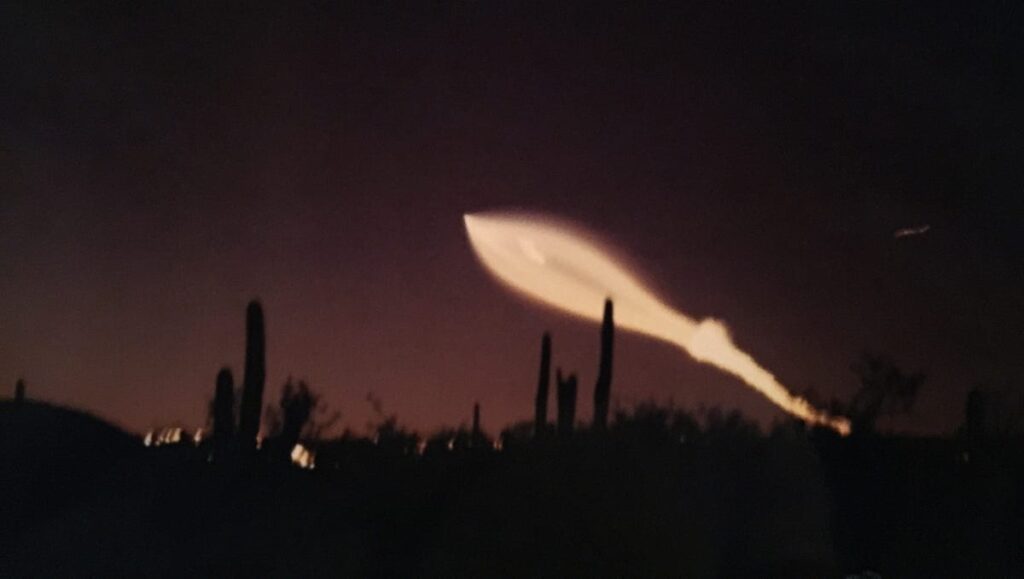Another of SpaceX’s Falcon 9 rockets is due to lift off once again in a matter of hours just two days after the spacecraft last off the ground Saturday, Oct. 25 from California.
A busy SpaceX is planning only one day off between its two most recent rocket launches from Southern California.
The commercial spaceflight company’s Falcon 9 rocket is due to lift off once again in a matter of hours just two days after the spacecraft last off the ground Saturday, Oct. 25 from the Vandenberg Space Force Base. The mission, unsurprisingly, is also another Starlink internet satellite deployment to orbit.
Missed the most recent rocket launch from the Santa Barbara County launch site? This could be your chance to try to see another Falcon 9 fly over Arizona before October comes to an end. The only problem? A mid-afternoon launch window that could make the spacecraft difficult to spot.
What’s more, postponements due to weather or issues with rockets are common with spaceflight. If you’re going to try to spot the rocket launch, check back with azcentral.com for any updates on the mission.
In the meantime, here’s what to know about the launch from Southern California, as well as when and where to potentially spot the rocket in Arizona.
What time is the SpaceX rocket launch?
SpaceX is working toward a Monday, Oct. 27, launch of its Falcon 9 rocket from the Vandenberg Space Force Base. The four-hour launch window opens at 2:13 p.m. PT, according to a launch alert from Vandenberg.
A Federal Aviation Administration operations plan advisory suggests a backup opportunity is available the next day if the launch were to be postponed.
Where is the next launch from California? What to know about trajectory
The launch will take place from Space Launch Complex 4E at Vandenberg Space Force Base in Santa Barbara County, California.
Like most launches from Vandenberg, the rocket will fly at a southeast trajectory.
What is the next mission from Vandenberg? SpaceX to deploy Starlink
SpaceX will launch its famous two-stage 230-foot Falcon 9 rocket, one of the world’s most active, to deliver 28 Starlink satellites into low-Earth orbit, a lower altitude where they’re able to circle Earth quickly.
California rocket launch could be visible in Arizona: Where to watch
Because of Arizona’s proximity to the launch site, there’s a good chance people there can see the spacecraft streak across the sky, especially at night or very early morning.
Here’s a list of some possible viewing locations compiled by The Arizona Republic, a USA TODAY Network publication.
- Dobbins Lookout, South Mountain, 10919 S. Central Ave., Phoenix, Arizona
- Papago Park, 625 N. Galvin Parkway, Phoenix, Arizona
- Fountain Hills, a town in Maricopa County, Arizona, which in 2018 was designated a Dark Sky Community with little light pollution
- Superstition Mountains, located 40 miles from metro Phoenix in Arizona
- Cave Creek, a town in Maricopa County about 30 miles north of Fountain Hills, Arizona
- Phoenix Sky Harbor International Airport, 3400 Sky Harbor Blvd., Arizona, which has a parking garage that is popular for plane-watching
- Black Canyon City, an unincorporated community in Yavapai County, Arizona
- Any mountain park in Arizona
- Estrella Mountain Regional Park, 14805 W. Vineyard Ave., Goodyear, Arizona
- Skyline Regional Park, 2600 N. Watson Road, Buckeye, Arizona
- White Tank Mountains, 20304 W. White Tank Mountain Road, Waddell, Arizona
- San Tan Mountain Regional Park, 6533 W. Phillips Road, Queen Creek, Arizona
- Monument Hill, a 150-foot slope on 115th Avenue, in Arizona
- Casa Grande, a city in Pinal County, approximately halfway between Phoenix and Tucson
- Avondale, a city in Maricopa County bordering Phoenix to the west
- Queen Creek, a suburb of Phoenix
What is SpaceX?
Billionaire Elon Musk, the world’s richest man, founded SpaceX in 2002.
The commercial spaceflight company is headquartered at Starbase in South Texas near the U.S.-Mexico border. The site, which is where SpaceX has been conducting routine flight tests of its 400-foot megarocket known as Starship, was recently voted by residents to become its own city.
SpaceX conducts many of its own rocket launches, most using the Falcon 9 rocket, from California and Florida. That includes a regular cadence of deliveries of Starlink internet satellites into orbit, and occasional privately funded commercial crewed missions on the Dragon – the only U.S vehicle capable of carrying astronauts to the International Space Station.
The most recent of SpaceX’s private human spaceflights, a mission known as Fram2, took place in April. SpaceX was also famously involved in funding and operating the headline-grabbing Polaris Dawn crewed commercial mission in September 2024.
SpaceX additionally benefits from billions of dollars in contracts from NASA and the Department of Defense by providing launch services for classified satellites and other payloads.
What is Starlink?
Starlink is SpaceX’s lucrative satellite internet business.
Owned by Musk, Starlink is a constellation of more than 8,000 satellites that provide internet service to customers around the world. SpaceX has spent more than six years delivering the satellites to orbit with a regular cadence of rocket launches from Florida and California.
While most satellite internet services operate from single geostationary satellites orbiting Earth at about 22,236 miles, Starlink is a constellation of thousands of satellites that operate from a low-Earth orbit, about 341 miles up. That allows Starlink’s satellites to have lower latency and data time between user and the satellite, improving performance of things like streaming, online gaming and video calls.
Residential plans for Starlink services start at $80 per month.
Eric Lagatta is the Space Connect reporter for the USA TODAY Network. Reach him at elagatta@gannett.com

